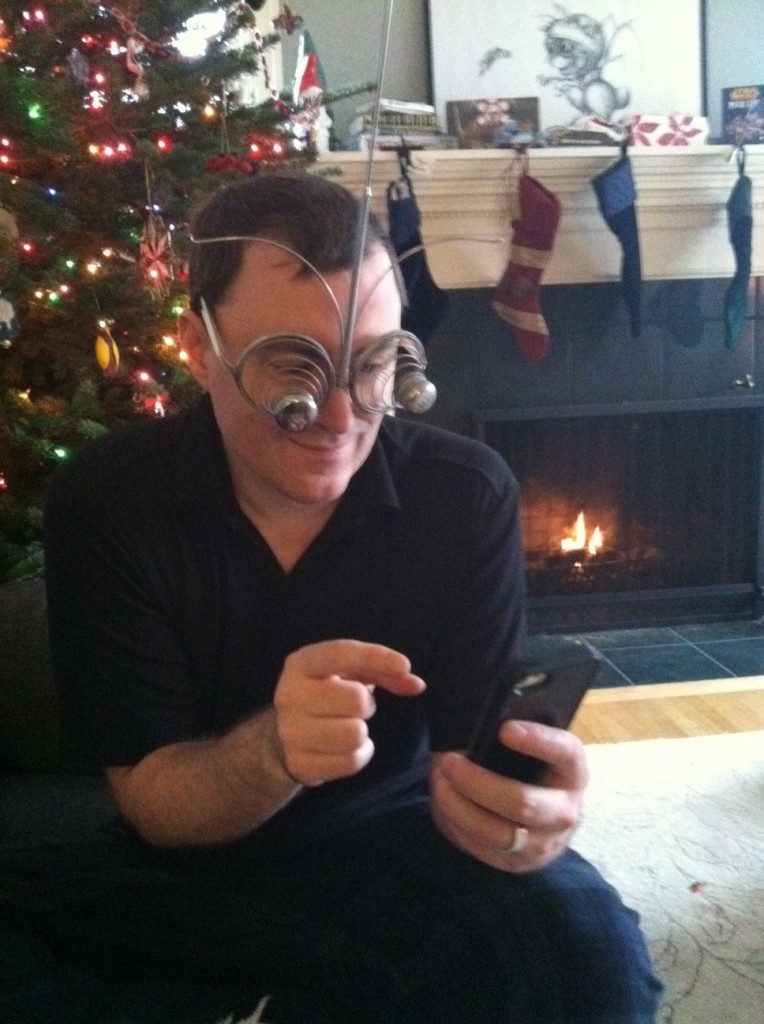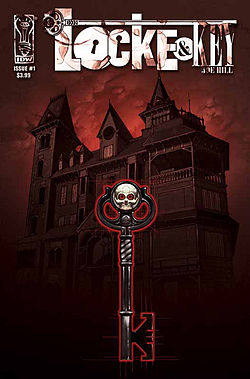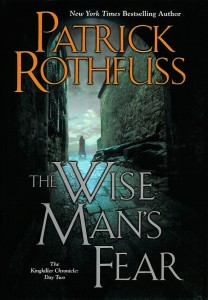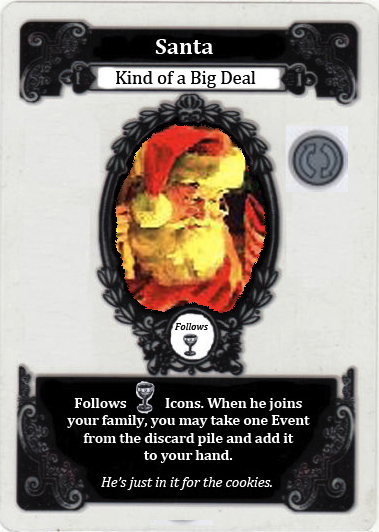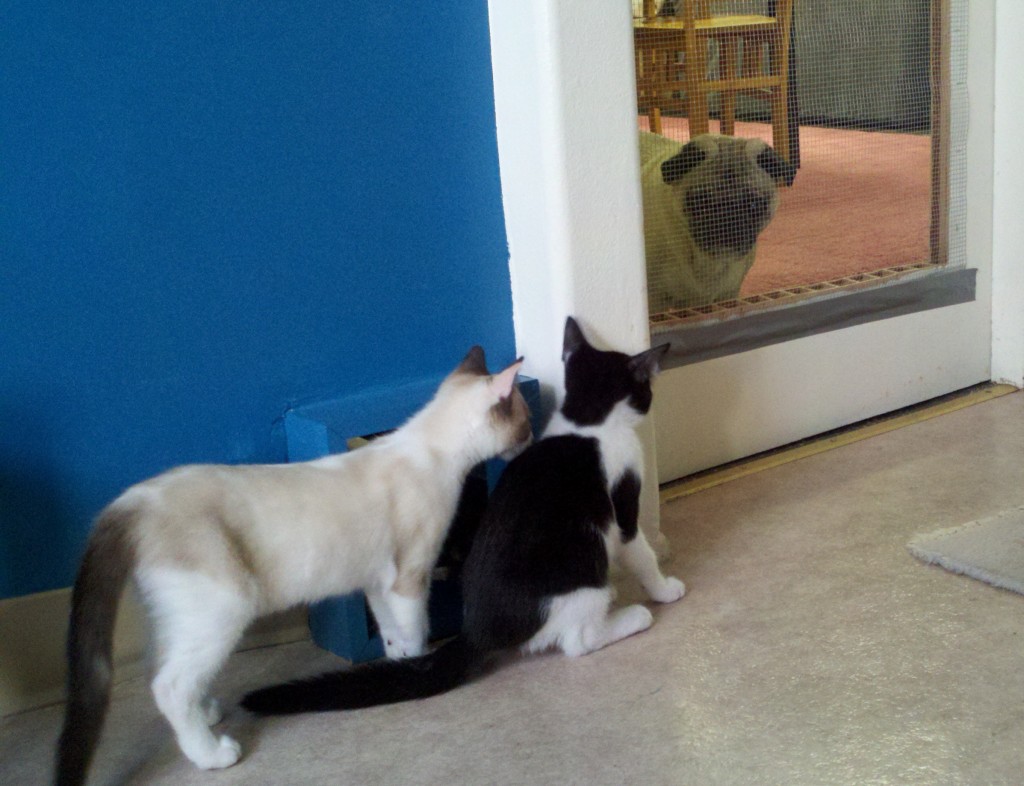Soon I’ll start talking about the new setting I’m working on, but for now here’s another round of Eberron answers to chew on. As always, these are just my personal opinions & aren’t canon in any way.
What can you tell us about the status of Eberron in the next edition?
At this point in time, I have no new information. It’s my hope that it will be supported, but I haven’t heard anything positive or negative in this regard.
When will you write more novels? Are you writing one now? Write one now.
As regards Eberron novels, that’s up to Wizards of the Coast, not me. Eberron belongs to WotC, and they are the only ones empowered to authorize Eberron stories. There’s lots of stories I’d like to tell, and this is one reason I’m working on a new setting – so that I’ll have free rein to develop fiction in that world.
In the unlikely event that a Warforged gained a dragonmark, would it replace the ghulra, or be its own thing?
A warforged getting a dragonmark is going to be a one of a kind story, so it’s up to you, really. Is the dragonmark somehow manufactured? Is the Prophecy declaring this warforged to be a tool of destiny? This will likely manifest in different ways. However, I personally wouldn’t replace the ghulra. The ghulra is, essentially, the true name of the warforged: the symbol of its soul. It is unique. A dragonmark is not unique; it can be shared by many people. It touches the soul, but it is not the entirety of it.
Can you provide an in game explanation about how the only interracial breeding possibilities are between human with orcs and elves?
First off, changelings and kalashtar can both interbreed with other races, including humans, Khoravar, and elves. However, these crossings don’t produce hybrids; a human-kalashtar crossing produces a human or a kalashtar, not a half-kalashtar. So to reframe the question, why are half-elves and half-orcs the only hybrid races?
First off, I see no reason to assume that other hybrids aren’t possible; it’s simply that if they are possible, the offspring are a) not sufficiently different from one of the parent races so as to require new mechanics, and/or b) are sterile or otherwise not true breeding. Essentially, if you were in my campaign and said “I want to play a half-dwarf… mechanically he’s a dwarf, he’s just a little skinny and people make fun of his mother” I’d allow it. But I wouldn’t give you any special abilities for it – you don’t get to take human-only feats. So there exists the possibility that half-elves and half-orcs aren’t the only hybrids. But they are still the only true-breeding hybrid races that possess their own unique racial traits, so let’s keep moving forward.
We’ll start with the Khoravar… that’s the name the half-elves of Eberron have given their race, for those who don’t know it. First off, as noted in the Dragonshard on the subject the elves themselves were surprised and disturbed when they had viable hybrid offspring. Why is this possible? It could be that it has little to do with humanity and everything to do with the elves. Remember that the elves are the product of genetic engineering; when the giants enslaved the people of Shae Tirias Tolai, they altered them and stripped them of their ability to slip through the Feywild, transforming eladrin into the modern elves. They were bred to be slaves; as such, it’s not unreasonable to think that they intentionally made them genetically adaptable to help maintain their stock. We’ve never discussed the possibility of, say, elf-goblin hybrids… but if you want to make things interesting, you could say that elves can breed with anything. It would explain the fifty shades of elf you find in many settings.
As for half-orcs, personally, I think orcs work in the same way. I don’t personally consider half-orcs to be specifically half-human, half-orc. In my opinion, a half-orc might be part hobgoblin, elf, shifter, or dwarf. Basically, the orc genes are dominant enough to produce a uniform set of traits when bred with other creatures; though with that said, I’d think that you would see some differences between the hobgoblin and shifter half-orcs. But mechanically they are identical. Why is this possible? It could simply be a bizarre evolutionary trait that has allowed the orc to thrive in difficult environments. Or it could have been a gift from Vvaarak – a blessing of fertility upon the first race of druids.
What if Siberys was not killed by Khyber, despite false myths that say the contrary? Or could he resurrect?
Well, assuming you take the Progenitor myth at face value, it’s hard for Siberys to be alive because the pieces of his body are scattered across the sky. The dragons were born from his blood, and the radiance of the Ring is in my opinion the primary source of the energy mortals manipulate with magic. If he’s not killed, you have no Ring, no dragons, and no magic.
Could he be resurrected? Anything’s possible. But I don’t know what you’d do with him if he was. We’re talking about a dragon wrapped around the world… a dragon who, in his first life, created entire planes for fun. Which means if he was alive again, there’s no particular reason for him to hang around in this one; he’d probably go and see how things were working out in Syrania and Irian, then swim off into the Astral to think about what to do next. The gravitational impact of this celestial motion would likely wreak all sorts of havoc, and there’s then the question of if there would still be arcane magic in the world if he left.
A key point here is that Siberys has no particular reason to care about humans. We’re children of Eberron, and late to the game at that. Even the dragons were born of his blood, not personally shaped by his hand; if anything, he’d be more interested in the outer planes, because those he worked on deliberately.
And worst comes to the worst, he’d want a second round with Khyber and might try to get Eberron to let her go. And Eberron is the world we are standing on. If Eberron were to rise, it would literally destroy the world as we know it.
So personally, I’d let sleeping dragons lie.
What kind of creatures dwell, by your reckoning and imagination as the creator of Eberron, within the distant Ring of Siberys.
Siberys is, in my mind, the source of arcane magic. Dragons are the children of Siberys and Eberron; as such they are mortal creatures whose blood is suffused with mystic power. Per Dragons of Eberron, the couatl were formed from “the pure blood of Khyber before it touched the earth.” So couatl are one example of creatures you might find in the Ring. The key to me is that natives of the Ring would likely be highly magical creatures, as much spirit as flesh; flight would also be a common thing. But beyond “look to the couatl as an example,” it’s not a subject I’ve given much thought.
Does Eberron exist in a specifically imagined Solar System; if so what are the other celestial bodies or major planets therein.
Nope. We defined the moons, and there are a lot of them; you could choose to spread them out as planets if you prefer. But we’ve never described other planets in the system. I believe there are other worlds – the daelkyr are described as having produced mind flayers when they destroyed the homeworld of the Gith – but we’ve never stated if these are physical worlds that can be reached through space travel or alternate material planes. It’s something I’m thinking about as I’m developing my new setting, but it wasn’t something that was considered for Eberron.
Why did Thrane reject Cyran refugees?
I’ll throw out a few factors.
- Like all of the Five Nations, Thrane’s resources were stretched thin by the war. Krozen’s top priority was to make sure he could tend to the needs of his own people.
- No one won the war. Cyre never conceded its position or acknowledged Thrane as a righteous victor. Many of those refugees are thus unrepentant enemy combatants. Even the civilians have the potential to form a hostile fifth column within the native population. Why should we put the safety and wellbeing of our own people at risk to help those who were, months ago, trying to kill them?
- The Mourning is utterly terrifying. An entire nation has been destroyed. No one knows why or how. Is it divine punishment of the Cyrans, and if so, will it follow them wherever they go? We need to regroup, consolidate our forces, and find out what it is and how to protect ourselves from it; this is not a time to take unnecessary risks.
There’s three reasons. Jaela would likely argue for compassion for those in need. Krozen would counter that the closed border protects the people of Thrane. And in the end, Jaela is the spiritual leader; it was Krozen and the cardinals who chose to refuse refugees.
On the other hand, while I understand the motives for Thrane’s rejection of the refugees, it seems odd since Breland welcomed them, and this puts the Flamers to shame given their beliefs in helping others.
The key here is to look at the event in context. The people of Thrane follow the faith of the Silver Flame. But they are also the people of Thrane, and have secular concerns that drive their daily lives. This isn’t a case of peaceful innocents hurt by a natural disaster. At the time of the Mourning, Thrane and Cyre had been at war for almost a century… and the last few decades of the war were fairly bitter between them. Consider the following, drawn from The Forge of War:
- In 978 YK, Cyre and Thrane were briefly allies. However, Cyre refused to aid Thrane against Brelish aggression. This led to a collapse of the alliance. One of the first conflicts following this was Cyre’s siege of Arythawn Keep. This was a brutal massacre. The Cyrans took no prisoners, and their warforged troops pursued those who fled, hunting them down tirelessly and slaughtering them. That’s an image that is very close to the minds of Thranes on the Cyran border: their own innocents being mercilessly pursued by Cyran troops.
- In 993 YK, Jaela Daran came to power and immediately sought peace with Cyre. Queen Dannel refused her entreaties, and Thrane soon learned that this was because Cyre had an ambitious plan to bring down Thrane with a direct assault on Flamekeep itself. Per Forge of War, while this plan was never executed, “Keeper Daran had no counter to High Cardinal Krozen’s claim that Cyre was a clear and present danger.” So again, when Cyre was seemingly punished by divine force for its folly, most Thranes felt little desire to aid the people who just years earlier had plotted to ravage Flamekeep.
In many ways, the question isn’t why Thrane didn’t help Cyre, but rather why Breland did. Breland and Thrane were allied against Cyre on the Day of Mourning. However, Breland had fewer bitter conflicts in its past – no incidents matching either of those I called out above. And to be more cynical, the fact of the matter is that the Cyran claim to the throne was always the best one. By taking in Oargev – keeping his former enemy close – Boranel put himself in a very strong position to control whatever future the nation may have. Breland’s actions may have been pure politics as much as humanitarian kindness.
I do believe that individual followers of the Flame quite likely provided aid to Cyran civilians in need, both before and after the Mourning; and remember, there are followers of the Flame in Breland as well as Thrane. But these incidents were the acts of compassionate individuals as opposed to the policy of a nation. Thrane’s refusal to aid Cyre was a secular act, not driven by faith; it was the act of a nation scarred by war, one that had offered the hand of peace in the past and been answered with betrayal and aggression.
Speaking of Cyre: was there ever anyone doubting what they were doing, when they were planning on attacking Flamekeep? That is, literally, the most important city for the Church of the Silver Flame… I can definitely imagine the shock people of Thrane felt, for those who found out about this (did it become public knowledge? because if so, yeah, Krozen is right in that you can’t expect Thranes to help the people from Cyre all that much)… Kind of insane, really, to consider destroying Flamekeep.
Who said anything about destroying it? We’re going to liberate it from the corrupt cardinals and false Keeper. And don’t forget, there are followers of the Flame who believe the theocracy is a mistake and source of corruption. Under Cyran rule, the church would be restored to its proper role.
Well, I mean, being seen to march against Flamekeep with the purpose of killing the Keeper, that would still cause some unrest, surely? Sure, the Church might have been too involved in secular matters, but going in there to try and kill Jaela Daran still wouldn’t go very well with most followers of the Church, even those outside of Thrane – Cyre isn’t exactly noted as a gathering point of the Silver Flame, so they can’t even do what Aundair might be able to pull off, and say they’re working towards protecting the true purpose of the Church, at least not while also being particularly convincing. Also, the Keeper was chosen by the Flame itself – then again, the queen could be trying to sell it as Jaela being false, so that could work, for those who would believe her.
Let me preface this by saying that the attacking Flamekeep scenario comes from The Forge of War, which I didn’t work on. As such, while I’m going to explain what I consider to be the logic behind it, it wasn’t my idea to begin with. But let me try.
The plan was not publicly known, nor did it involve fighting through Thrane. According to Forge of War , the idea was to defeat Thrane with a single massive naval assault on Flamekeep, with the idea that if Flamekeep could be seized Thrane would be forced to capitulate. With this in mind…
- This plan was driven by the fact that there was a new, inexperienced Keeper… and surely enhanced by the fact that she was a child, something unprecedented in history.
- I don’t think the plan was ever to “kill the Keeper.” Rather, it would be a matter of taking her as a hostage. Dannel would have a couple of angles she could work. First of all, she would be dissolving the flawed theocracy and restoring the church to its proper role as spiritual guardian. Second, she would be essentially serving as a regent. This child Keeper is too young to handle such responsibility; Dannel will protect her and guide her as she grows into her role. With the subtext being “she is our prisoner and we could kill her if we wanted.” Many followers of the Flame had doubts about the theocracy, and false Keepers aside, the idea of a child Keeper would seem strange to many. So Dannel presents herself as a protector restoring things to their proper place… not a destroyer or assassin. Rather, she kills Krozen, pinning all the blame on him for corruption and leading the church astray.
- The plan wasn’t publically known. I would imagine that the force being chosen for the assault would be carefully vetted, either being loyal vassals of the Sovereign Host who would be happy to weaken the Flame, or followers of the Flame who strongly opposed the theocracy.
- When Krozen exposed the plan, you can be sure that he painted it in the worst possible light. He likely accused them of wanting to kill Jaela, and if it was me, I’d say that Dannel planned to declare Oargev as a new puppet Keeper (doubly infuriating because the Keeper is chosen by the Flame, not by mortals). So yes, this infuriated both Thranes and other loyal followers of the Flame in other countries. The plan was thus never carried out; once warned the Thranes surely bolstered their defenses, and beyond that the public sentiment in all nations would make it an unwise move.
But yes, you can see why this would make Thranes unsympathetic to the Cyran refugees… if you go with the idea of Krozen presenting Oargev as Dannel’s would-be puppet Keeper, you can doubly see why there would be no hope of setting up a New Cyre in Thrane; I’d further play up a large segment of Thranes – and even Flame loyalists in Breland – bitterly hating Oargev in the present day.
Can the SF be a good deity and not just an impersonal force?
The Silver Flame isn’t an impersonal force. It’s a force of positive energy that holds mighty demons at bay. When Bel Shalor escaped his bonds and threatened Thrane, it reached out to Tira and gave her the power she needed to defend her people. Since then, it has continued to empower noble souls to defend the innocent. It calls paladins to service and grants its power to the most faithful of its servants. It’s not an impersonal force. It doesn’t grant its gifts to everyone. When Overlords ravage the land, it doesn’t ignore the people in need.
However, it’s not an anthropomorphic entity. It’s a gestalt of thousands of noble souls, many of which were never human. It doesn’t view the world as a human would, nor does it value humans more highly than other mortals; an orc and a human are equally worthy of its gifts, if they have noble aims. It exists to defend the mortals of Eberron from supernatural threats: demon lords who would collapse the world into chaos; undead forces that would drain the life from it; a plague of lycanthropy that could consume nations. It takes no stand on conflicts between mortals, whether that’s humans fighting humans or humans fighting orcs. It was kindled by couatls fighting demons before human civilization existed. It grants its agents the power to save humanity from demons; it is up to the humans to use that power wisely when no supernatural threat exists. In judging a mortal soul, it doesn’t view it the same way as we might. It responds to faith, selflessness, the desire to help others. Tira, Krozen, Jaela, and Dariznu all share faith and a fierce determination to help their fellow mortals, and it is this that binds them all to the Flame. It’s simply that they all have different ideas about the form this help should take. Dariznu believes that publicly burning dissidents alive is the only way to bring others to the righteous path; Jaela finds this to be horrifying, while Krozen considers it a necessary sacrifice to maintain order in Thaliost. All three believe that their actions and approaches help people… and that is what the Flame responds to. It’s also the case that the Flame can only act through its agents. When Bel Shalor threatened Thrane, the Flame couldn’t simply blast him; it could only empower Tira to do what needed to be done. The Flame isn’t an impersonal force. It was formed from a great sacrifice, and ever since then it has protected the world from evil. But it is only as strong as its mortal agents. It gives noble souls the power to do good; it’s up to them to live up to the promise of their own souls.
If you want the Silver Flame to be more active, I wouldn’t do this through the Flame itself; rather, I’d turn to the Voice of the Flame. Tira’s spirit is the bridge between Church and Flame. Per canon, her role is subtle and passive… it is the quiet voice that urges you to do good, set against the subtle influence of Bel Shalor pushing you towards darkness. If I want to give someone a divine vision from the Flame, I’d have it come from Tira. But personally, I don’t want the Flame itself to be actively intervening in the daily lives of most people, because it strips a depth from the stories. I want the PCs to be the ones who have to decide what to do about Dariznu – is he actually serving a greater good, as he believes? Do they have the right to bring him down, and have they thought about what happens after? If the Flame itself personally sanctions this action, it becomes clear-cut and to my mind, less interesting. As is, the Flame empowers your paladin because you have the conviction to do good, and the potential to do good. But it’s up to you to live up to that potential, and to make the right choices.
 While my next big thing is a long-term project, I’ve got a number of small things in the hopper. One hit shelves today: The Kobold Guide to Worldbuilding. This is an anthology of essays by a host of talented designers, including people I’ve worked with in the past and others whose work I’ve long admired. The topics range from very broad to quite narrow; some look at things from a high level, whereas others are more practical… how to design a cult, a guild, a tribe, a nation. I contributed two essays, “How to make a High-Magic World” and “Bringing History to Life.” I’ve only just received my other’s copy, so I’m still digesting the other essays in the book. So far I’m enjoying it, and as someone currently designing a new setting, it’s given me a lot of things to think about. Wolfgang Baur will have more to say about the Guide in this week’s Six Questions, but until then, take a look for yourself at Drivethru RPG, Createspace, or Amazon!
While my next big thing is a long-term project, I’ve got a number of small things in the hopper. One hit shelves today: The Kobold Guide to Worldbuilding. This is an anthology of essays by a host of talented designers, including people I’ve worked with in the past and others whose work I’ve long admired. The topics range from very broad to quite narrow; some look at things from a high level, whereas others are more practical… how to design a cult, a guild, a tribe, a nation. I contributed two essays, “How to make a High-Magic World” and “Bringing History to Life.” I’ve only just received my other’s copy, so I’m still digesting the other essays in the book. So far I’m enjoying it, and as someone currently designing a new setting, it’s given me a lot of things to think about. Wolfgang Baur will have more to say about the Guide in this week’s Six Questions, but until then, take a look for yourself at Drivethru RPG, Createspace, or Amazon!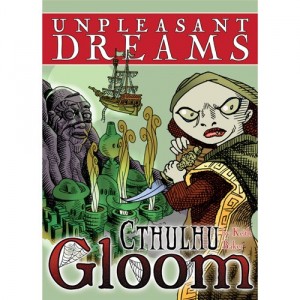 Beyond this, my most recent releases are all tied to my love of Lovecraft. Unpleasant Dreams is an expansion for Cthulhu Gloom, adding new Stories, Transformations, Guests, and more; I discuss it in more detail in this post. Earlier this year I released Cthulhu Fluxx, which brings a little much-needed madness to the chaos of Fluxx. While it keeps the overall structure of Fluxx – get the Keepers you need to meet the shifting goal, while dealing with the ever-changing rules – Cthulhu Fluxx adds a second layer. You’re trying to win for yourself, but you also need to work with the other players to keep everyone from losing. No one wins if Cthulhu rises… with the possible exception of the secret cultist, if one is out there! It was a fun challenge as a designer, and I’m happy with the results.
Beyond this, my most recent releases are all tied to my love of Lovecraft. Unpleasant Dreams is an expansion for Cthulhu Gloom, adding new Stories, Transformations, Guests, and more; I discuss it in more detail in this post. Earlier this year I released Cthulhu Fluxx, which brings a little much-needed madness to the chaos of Fluxx. While it keeps the overall structure of Fluxx – get the Keepers you need to meet the shifting goal, while dealing with the ever-changing rules – Cthulhu Fluxx adds a second layer. You’re trying to win for yourself, but you also need to work with the other players to keep everyone from losing. No one wins if Cthulhu rises… with the possible exception of the secret cultist, if one is out there! It was a fun challenge as a designer, and I’m happy with the results. I’ll be talking about my next big thing soon; we’re still catching up from the chaos of the holidays, and I’m getting back into my work groove. I hope that 2013 is treating you well so far!
I’ll be talking about my next big thing soon; we’re still catching up from the chaos of the holidays, and I’m getting back into my work groove. I hope that 2013 is treating you well so far!

